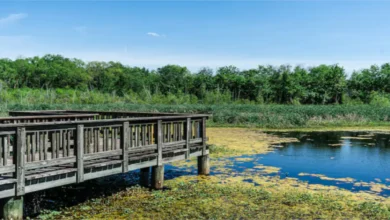Nadine Storm: A Historic Force of Nature
Record-Breaking Storm That Shaped Meteorological Research

As one of the most unique and significant storms to ever form in the Atlantic, Nadine Storm will live on in history. It was a challenge to the communities it passed through and a subject of intrigue for meteorologists due to its extended longevity, unpredictable movement, and intricate interactions with the atmosphere. We can comprehend why Nadine Storm is unique in meteorological history by delving further into its origin, behavior, and effects.
The Birth of Nadine Storm
A tropical wave that originated on the African coast gave rise to the Nadine Storm. As it advanced westward, this low-pressure system intensified over the Atlantic’s warm waters. It gained the moniker “Nadine” after intensifying into a tropical depression and then a tropical storm in a matter of days.
During the height of hurricane season, when conditions are ideal for swift storm development, meteorologists kept a careful eye on Nadine’s formation. Warm sea surface temperatures, little wind shear, and humid air created the perfect conditions for the storm to intensify. Nadine had already shown a well-organized structure by the time it developed into a tropical storm, with a dense overcast center and spiraling belts of thunderstorms.
Unpredictable Path and Erratic Movement
Nadine Storm was especially unique because of its convoluted course. Nadine’s path was unpredictable, in contrast to the more regular path of most Atlantic storms. It wandered over the Atlantic for weeks, looping and halting in ways that were not consistent with conventional forecasting models.
Because of Nadine’s erratic movements, meteorologists faced many difficulties. Usually, forecasts depend on known trends and steering currents, but Nadine kept changing course. There was a period when it traveled northeast, then south, and then south again. Plans for coastal readiness were disturbed by these sudden changes in direction, which made it difficult to forecast its impact on land.
Nadine interacted with several weather systems, including a blocking high-pressure ridge and a mid-latitude trough, during its record-breaking 22-day duration. These interactions added to its lifespan and further complicated its trajectory. Given how long the storm lasted over the Atlantic, it was unclear how long one storm might continue to be strong before weakening.
The Intensity of Nadine Storm
Nadine was powerful even though it never attained the destructive power of a Category 4 or 5 storm. At its strongest, the storm was a Category 1 hurricane, with sustained maximum winds of about 80 mph. Despite being a moderate cyclone by hurricane standards, Nadine posed a significant threat due to its tenacity.
Nadine was unique not only because of its maximum intensity but also because of how long its powerful winds and torrential rains lasted. The storm caused massive surges that spread far from its center over a period of weeks, affecting coastal regions in the Azores, Europe, and even sections of the eastern United States. These swells caused to localized flooding in low-lying regions and produced hazardous surf conditions.
Nadine had a distinct structure even though it was a tropical storm. It was an anomaly in Atlantic hurricane history because of its consistent intensity over such a long time. Storms typically diminish rapidly when they come into contact with cooler waters or unfavorable air conditions, but Nadine did not behave as expected.
Impact on Land and Coastal Communities
Even though Nadine mostly passed over open sea, its effects could still be felt on land. As Nadine passed close by, the Azores, a chain of Portuguese islands in the mid-Atlantic, had coastal flooding, torrential rains, and strong gusts. Residents stocked up on emergency supplies, secured their homes, and pruned trees in preparation for the storm.
Parts of western Europe were also affected by the storm, in addition to the Azores. Heavy rains and high surf interrupted maritime activity and caused localized flooding. Coastal roads were briefly closed, ferry services were suspended, and shipping routes were changed. Due to the storm’s protracted duration, these effects persisted for days, placing a burden on nearby resources and necessitating prolonged recovery efforts.
The risk of floods was also increased by Nadine’s slow motion. Farmland and infrastructure were threatened as rivers and streams in the impacted areas overflowed their banks. Communities in several areas had to rebuild long after the storm passed since the floods destroyed roads, houses, and crops.
Nadine Storm’s Influence on Meteorology
Nadine Storm was a complicated case study for meteorologists. It posed a challenge to forecasting methods due to its peculiar course, long duration, and interactions with other meteorological systems. Using satellite photos, spy planes, and sophisticated computer models, meteorological organizations from all over the world kept a careful eye on Nadine’s activity in order to comprehend its dynamics.
For slow-moving storms, Nadine emphasized the significance of enhancing long-term forecasts. Hurricane predictions are typically made 24 to 72 hours in advance, however Nadine showed that more precise long-range models are required. Scientists learned a lot about how storms may linger and veer for weeks by examining how Nadine interacts with atmospheric ridges, troughs, and jet streams.
Nadine also sparked investigations into the mechanisms that enable storms to sustain their intensity over colder waters. Nadine remained strong for a longer period of time than anticipated, since most tropical cyclones swiftly lose strength after leaving warm tropical waters. This anomaly led researchers to look into how vertical wind shear, ocean heat content, and atmospheric stability support storm activity.
Lessons Learned from Nadine Storm
Nadine Storm’s erratic nature and protracted lifespan brought to light the importance of preparedness and flexibility in disaster response. Coastal communities learned that even a hurricane that never makes direct landfall may cause significant disruptions. Due to the storm’s prolonged duration, emergency planners had to remain vigilant for weeks, adapting their strategies as forecasts changed.
The necessity of improved public communication was one important lesson learned. Local governments and meteorological organizations provided timely updates to residents in the Azores and other impacted locations. Because of the ambiguity surrounding Nadine’s route, it was imperative that officials deliver accurate, frequent, and unambiguous information. This event made clear how crucial it is to preserve public confidence in forecasting organizations and make sure that warnings are taken seriously.
Nadine established itself as a standard for storm longevity research by the scientific community. By advancing hurricane modeling, the data gathered during Nadine’s voyage assisted forecasters in predicting future storms of a similar nature. We can now better predict and prepare for long-lasting, unpredictable systems because we have a better knowledge of how and why Nadine acted as it did.
Nadine Storm’s Legacy
Nadine Storm made a significant contribution to the fields of disaster preparedness and meteorology. It differs from other Atlantic hurricanes due to its unusual features, including its record-breaking longevity, unpredictable movement, and persistent intensity. Its complexity and impact earned it a place in history, even though its wind speed may not have been the strongest.
Weather organizations have improved public awareness campaigns, communication tactics, and forecasting systems in the years following Nadine by applying the lessons learnt. Nadine shown that even a mild hurricane can have a significant impact, particularly if it lasts for a long time.
Conclusion: Nadine Storm’s Place in History
The tale of Nadine Storm is one of tenacity, uncertainty, and important lessons. We can better understand the difficulties that storms like Nadine pose by looking at its origin, movement, and effects. Its extraordinary behavior and record-breaking lifetime serve as a reminder that nature frequently defies expectations and pushes the limits of our scientific knowledge.
The insights from Nadine will continue to guide our progress in disaster preparedness and meteorological research. We can increase prediction accuracy, strengthen coastal communities, and create a more resilient future by taking lessons from storms like Nadine.
Final Thoughts on Nadine Storm
We learned from Nadine Storm that the force of nature is both awe-inspiring and unpredictable. It had a profound impact on meteorological history due to its peculiar trajectory, unprecedented lifetime, and extensive effects. As communities recovered and researchers examined its trends, the storm provided important information about resilience, planning, and forecasting.
The lessons learned from Nadine Storm serve as a reminder that forethought, precise forecasting, and effective communication can have a significant impact. Even if nature is beyond our complete control and prediction, the lessons learned from storms like Nadine guarantee that we are better prepared to handle obstacles in the future. Ultimately, Nadine Storm serves as a reminder of the intricacy of nature as well as a chance to improve our knowledge and preparedness.
Contact Us For More Information





